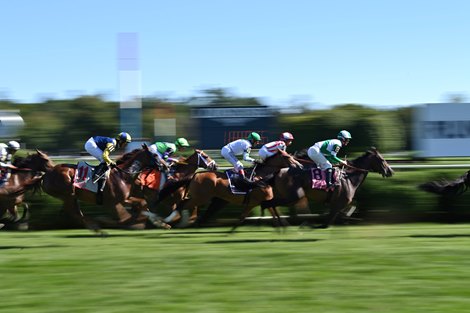A team of researchers aiming to identify racehorses at risk of catastrophic or career-ending injury through stride monitoring applied Sept. 23 to the Kentucky Equine Drug Research Council for funding in what they call a final push to implement their potentially life-saving measures view program.
The KEDRC is under the jurisdiction of the Kentucky Horse Racing Commission and reviews and makes recommendations on drug policy and in reviewing research projects eligible for KHRC funding.
The step monitoring presentation was given by Dr. Warwick Bayly, a professor in the Department of Veterinary Clinical Services at the College of Veterinary Medicine at Washington State University, and Dr. David Lambert, a veterinarian and CEO of StrideSAFE, the company that developed the biometric sensor system that collects the stride analysis data.
“This is the fourth year that Dr. “Lambert and others are looking for ways to identify horses that are at greater risk of sustaining stern musculoskeletal injuries in the course of their (race) preparation, ending their careers or, in the worst cases, suffering catastrophic injuries,” said Bayly. “We felt like we had to do this. It’s the right thing to do.”
The StrideSAFE system began testing in 2020 Emerald Downs. Using sensors on the legs, behind the girth and under the saddle pad, the team collected the data needed to develop a single monitor that fits into the saddlecloth and measures acceleration in three different planes – longitudinal (up and down). and in the vertical direction (front and back) and medial-lateral (side to side). The data collected creates a step profile, which Bayly calls a step “fingerprint.”
Sign in Blood horse Daily
These fingerprints can then be compared to an “ideal step,” a composition created from the analysis of 30 sound level 1 and 2 winners.
In trials during morning work and races conducted in collaboration with the Up-to-date York Racing Association, Bayly and Lambert developed a system for labeling a horse's level of risk. If a horse's stride was less than 1.9 standard deviations from the ideal stride, it received a “green lithe,” meaning the lowest risk of injury. A horse with a stride of 2-2.9 standard deviations from ideal received a “yellow lithe,” and horses whose stride was three or more standard deviations from ideal were labeled a “red lithe.”
The risk factor for a “red lithe” horse suffering a career-ending or catastrophic injury was rated 142 with a standard score of 6-7.9, compared to “green lithe” horses rated a one.
Armed with this system, Bayly said it's time to create a practical, economical and automated system that flags candidates so they can then be examined more thoroughly by a veterinarian or apply CT scans or scintigraphy. He proposed a study of 2,000 horses, which, according to the NYRA study, should include about 12% with variation in stride length. Of the estimated 240 Red Flag horses, the veterinary inspection will likely identify 20 that require a thorough examination, and 10 of those horses will likely require advanced imaging as part of their diagnosis.
“In the long term, we want to get first-class data so that every horse goes into a race with a green flag,” said Lambert. “Then you would almost be guaranteed that everyone would get through the area safely, which is crucial for the gigantic, televised races.”
The council also heard a lecture from Dr. Scott Stanley, the head of the Equine Analytical Chemistry Laboratory at the University of Kentucky, who proposed research to develop gene doping detection methods that would identify transgene administration. The test would identify genes synthesized to influence muscle growth, cell growth and tissue repair, oxidative capacity and metabolism.
“The research aims to develop a methodology that utilizes modern techniques that have been developed and proven to detect transgenes for EPO (erythropoietin),” Stanley said, adding that he has started with an LRC laboratory outside of Tokyo, which consists of eight members. The team works in the Genetic Analysis Department to detect gene doping.
“They have been involved in IFHA and collaborations in Australia, Hong Kong and France,” he said. “I have been working with them for five years and they are willing to share their methodology. They pioneered the equine anti-doping field for digital droplet PCR methodology and we hope to work with them to expand testing beyond erythropoietin to other targets.”
One of the long-term goals is to include gene doping results in the Equine Biological Passport database.
Stanley estimated it would take up to a year to acquire the digital droplet PCR equipment and develop the methodology, as well as another year to validate the tests using KHRC blood samples and begin conducting trials .
The Equine Drug Research Council did not take votes but closed the meeting by agreeing to collect further questions from council members. A final review of the proposals and a vote on whether they will receive funding support will take place at a later meeting.


